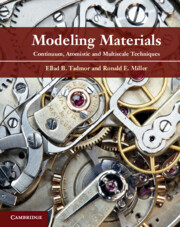Book contents
- Frontmatter
- Contents
- Preface
- Acknowledgments
- Notation
- 1 Introduction
- Part I Continuum mechanics and thermodynamics
- 2 Essential continuum mechanics and thermodynamics
- Part II Atomistics
- Part III Atomistic foundations of continuum concepts
- Part IV Multiscale methods
- Appendix A Mathematical representation of interatomic potentials
- References
- Index
2 - Essential continuum mechanics and thermodynamics
from Part I - Continuum mechanics and thermodynamics
Published online by Cambridge University Press: 05 June 2012
- Frontmatter
- Contents
- Preface
- Acknowledgments
- Notation
- 1 Introduction
- Part I Continuum mechanics and thermodynamics
- 2 Essential continuum mechanics and thermodynamics
- Part II Atomistics
- Part III Atomistic foundations of continuum concepts
- Part IV Multiscale methods
- Appendix A Mathematical representation of interatomic potentials
- References
- Index
Summary
A solid material subjected to mechanical and thermal loading will change shape and develop internal stresses. What is the best way to describe this? In principle, the behavior of a material (neglecting relativistic effects) is dictated by that of its atoms, which are governed by quantum mechanics. Therefore, if we could solve Schrödinger's equation (see Chapter 4) for 1023 atoms and evolve the dynamics of the electrons and nuclei over “macroscopic times” (i.e. seconds, hours and days) we would be able to predict material behavior. Of course when we say “material,” we are already referring to a very complex system as demonstrated in the previous chapter. In order to predict the response of the material we would first have to construct its structure in the computer, which would require us to use Schrödinger's equation to simulate the process by which it was manufactured. Conceptually, it is useful to think of materials in this way, but we can quickly see the futility of the approach; state-of-the-art quantum calculations involve mere hundreds of atoms over a time of nanoseconds.
At the other extreme to quantum mechanics lie continuum mechanics and thermodynamics. These disciplines completely ignore the discreteness of the world, treating it in terms of “macroscopic observables,” time and space averages over the underlying swirling masses of atoms. This leads to a theory couched in terms of continuously varying fields. Using clear thinking inspired by experiments it is possible to construct a remarkably coherent and predictive framework for material behavior.
Information
- Type
- Chapter
- Information
- Modeling MaterialsContinuum, Atomistic and Multiscale Techniques, pp. 21 - 112Publisher: Cambridge University PressPrint publication year: 2011
